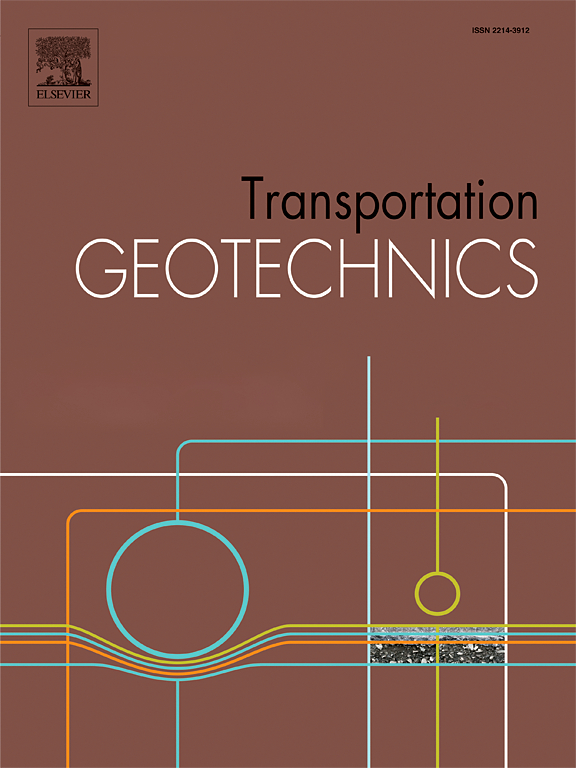Application of physical model test in underground engineering: A review of methods and technologies
IF 4.9
2区 工程技术
Q1 ENGINEERING, CIVIL
引用次数: 0
Abstract
Underground engineering occurs in a multi-field coupling geological environment, exhibiting deformation characteristics of nonlinearity, discontinuity and timeliness, with a complex disaster evolution mechanism. Physical model tests can intuitively reproduce the evolution process of engineering disasters, which are important means of studying scientific problems in underground engineering and disaster prevention. On the basis of summarizing and reviewing research achievements on the physical model test of underground engineering in five aspects: similarity theory, physical model construction, multi-field environment simulation, engineering activity reproduction and multi-source information monitoring, the future prospects of physical model test of underground engineering are proposed. It is found that the hypergravity simulation technology can widen the parameter selection range of similar materials by extending the similarity constant. The physico-mechanical properties of similar materials can be regulated quantitatively by changing the raw material proportion and mixture ratio. The curing principle of similar materials can be classified as physical compaction, inorganic cementation, organic cementation, molten sintering, and ultraviolet curing. The construction technologies of physical models can be divided into mold method, masonry method and 3D printing method. The creation of physical fields such as true triaxial stress, water pressure, temperature, gas pressure, and stress gradients, as well as the reproduction of engineering activities such as cavern excavation and tunnel mining, can be realized in a physical model. Model test monitoring technologies and data processing methods are used for data collection, processing and interpretation in the entire testing process. It is recommended to further refine the similarity theories for simulating the whole process of engineering disasters, optimize the performance of similar materials, develop refined preparation technologies of complex three-dimensional structures, similar revivification technologies of multi-field coupling environments, high-quality reproduction technologies of engineering activities, and whole-domain multi-source intelligent monitoring systems.
物理模型试验在地下工程中的应用:方法与技术综述
地下工程发生在多场耦合的地质环境中,具有非线性、不连续、时效性等特点,灾害演化机制复杂。物理模型试验可以直观地再现工程灾害的演变过程,是研究地下工程和防灾科学问题的重要手段。在总结和回顾地下工程物理模型试验在相似理论、物理模型构建、多场环境模拟、工程活动再现和多源信息监测五个方面的研究成果的基础上,提出了地下工程物理模型试验的未来发展前景。研究发现,超重力模拟技术可以通过扩大相似常数来扩大相似材料的参数选择范围。通过改变原料配比和混合比例,可以定量调节相似材料的物理力学性能。同类材料的固化原理可分为物理压实、无机胶结、有机胶结、熔融烧结、紫外线固化。物理模型的施工技术可分为模具法、砌体法和3D打印法。在物理模型中可以实现真三轴应力、水压、温度、瓦斯压力、应力梯度等物理场的创建,以及洞室开挖、隧道开采等工程活动的再现。在整个试验过程中,采用模型试验监测技术和数据处理方法进行数据采集、处理和解释。建议进一步细化模拟工程灾害全过程的相似理论,优化相似材料的性能,发展复杂三维结构的精细化制备技术、多场耦合环境的相似复活技术、工程活动的高质量再现技术、全域多源智能监控系统。
本文章由计算机程序翻译,如有差异,请以英文原文为准。
求助全文
约1分钟内获得全文
求助全文
来源期刊

Transportation Geotechnics
Social Sciences-Transportation
CiteScore
8.10
自引率
11.30%
发文量
194
审稿时长
51 days
期刊介绍:
Transportation Geotechnics is a journal dedicated to publishing high-quality, theoretical, and applied papers that cover all facets of geotechnics for transportation infrastructure such as roads, highways, railways, underground railways, airfields, and waterways. The journal places a special emphasis on case studies that present original work relevant to the sustainable construction of transportation infrastructure. The scope of topics it addresses includes the geotechnical properties of geomaterials for sustainable and rational design and construction, the behavior of compacted and stabilized geomaterials, the use of geosynthetics and reinforcement in constructed layers and interlayers, ground improvement and slope stability for transportation infrastructures, compaction technology and management, maintenance technology, the impact of climate, embankments for highways and high-speed trains, transition zones, dredging, underwater geotechnics for infrastructure purposes, and the modeling of multi-layered structures and supporting ground under dynamic and repeated loads.
 求助内容:
求助内容: 应助结果提醒方式:
应助结果提醒方式:


